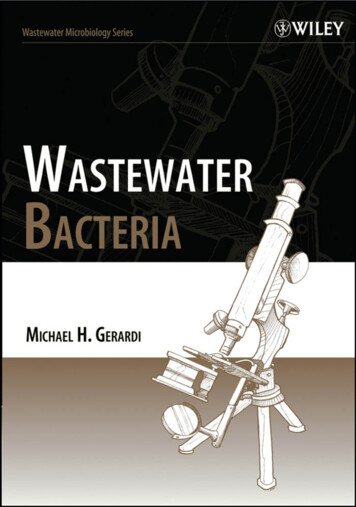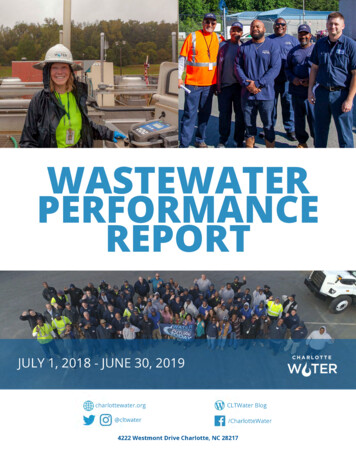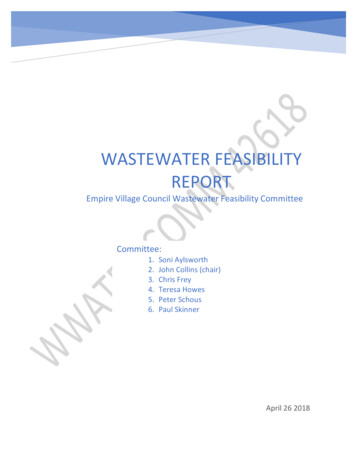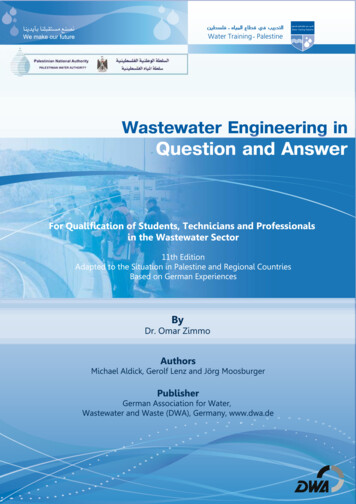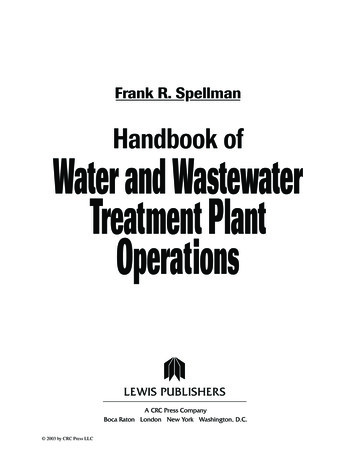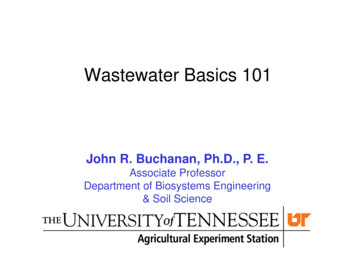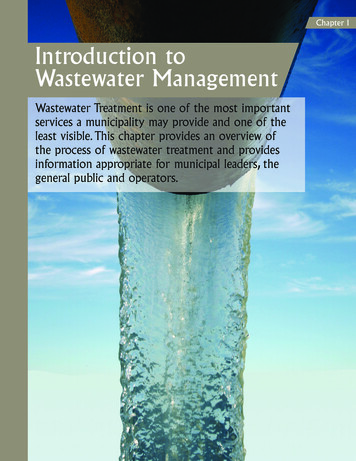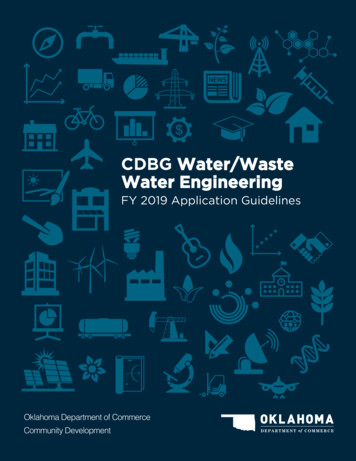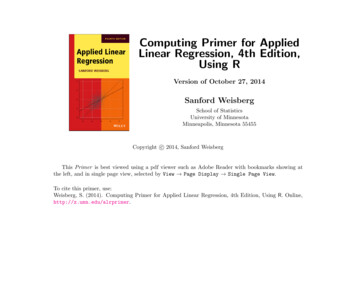
Transcription
United StatesEnvironmental ProtectionAgencyOffice of WaterOffice of Wastewater ManagementWashington DC 20460Primer for MunicipalWastewater TreatmentSystemsEPA 832-R-04-001September 2004
Primer for Municipal Wastewater Treatment SystemsClean Water Act Requirements for Wastewater Treatment4The Need for Wastewater Treatment5Effects of Wastewater on Water Quality5Some of the Key Challenges Faced by Wastewater Treatment Professionals Today6Collecting and Treating WastewaterCentralized CollectionCombined Sewer SystemsSanitary Sewer SystemPollutants:Oxygen-Demanding SubstancesPathogensNutrientsSynthetic Organic and Inorganic ChemicalsThermal6679888888Wastewater TreatmentPrimary TreatmentPreliminary TreatmentPrimary SedimentationBasic Wastewater Treatment ProcessesPhysicalBiologicalChemicalSecondary TreatmentAttached Growth ProcessesSuspended Growth ProcessesLagoonsLand TreatmentSlow Rate InfiltrationRapid InfiltrationOverland FlowConstructed WetlandsDisinfectionChlorineOzoneUltraviolet etreatment16Advanced Methods of Wastewater TreatmentNitrogen ControlBiological Phosphorus ControlCoagulation-SedimentationCarbon Adsorption1717181819The Use or Disposal of Wastewater Residuals and BiosolidsLand ApplicationIncinerationBeneficial Use Products from Biosolids19202021Decentralized (Onsite or Cluster) SystemsTreatmentConventional Septic TanksAerobic Treatment UnitsMedia FiltersDispersal ApproachesAbsorption FieldMound SystemDrip Dispersal SystemEvapotranspiration BedsManagement of Onsite/Decentralized Wastewater Systems2122222222232323242424Asset ManagementOperationMaintenance242525Common Wastewater Treatment Terminology25
Clean Water Act Requirements forWastewater TreatmentThe 1972 Amendments to the FederalWater Pollution Control Act (Public Law 92500–, known as the Clean Water Act (CWA),established the foundation for wastewaterdischarge control in this country. The CWA’sprimary objective is to ‘restore and maintain thechemical, physical and biological integrity of thenation’s waters.’The CWA established a control program forensuring that communities have clean waterby regulating the release of contaminantsinto our country’s waterways. Permits thatlimit the amount of pollutants dischargedare required of all municipal and industrialwastewater dischargers under the NationalPollutant Discharge Elimination System (NPDES)permit program. In addition, a constructiongrants program was set up to assist publiclyowned wastewater treatment works build theimprovements required to meet these new limits.The 1987 Amendments to the CWA establishedState Revolving Funds (SRF) to replace grants asthe current principal federal funding source forthe construction of wastewater treatment andcollection systems.Over 75 percent of the nation’s population isserved by centralized wastewater collectionand treatment systems. The remainingpopulation uses septic or other onsite systems.Approximately 16,000 municipal wastewatertreatment facilities are in operation nationwide.The CWA requires that municipal wastewatertreatment plant discharges meet a minimum of‘secondary treatment’. Over 30 percent of thewastewater treatment facilities today producecleaner discharges by providing even greaterlevels of treatment than secondary.4
Primer for MunicipalWastewater TreatmentSystemsThe Need for Wastewater Treatmentproduced can greatly alterpeople to use the water forthe amount and complexitybeneficial purposes. PastWastewater treatment isof industrial wastes andapproaches used to controlneeded so that we canchallenge traditionalwater pollution control mustuse our rivers and streamstreatment technology. Thebe modified to accommodatefor fishing, swimming andapplication of commercialcurrent and emerging issuesdrinking water. For the firstfertilizers and pesticides,half of the 20th century,combined with sedimentpollution in the Nation’sfrom growing developmenturban waterways resulted inactivities, continues to be afrequent occurrences of lowsource of significant pollutiondissolved oxygen, fish kills,as runoff washes off thealgal blooms and bacterialland.contamination. Early effortsWater pollution issues nowin water pollution controldominate public concernsyears, the natural treatmentprevented human wasteabout national water qualityprocess in streams andfrom reaching water suppliesand maintaining healthylakes was adequate toor reduced floating debrisecosystems. Although aperform basic wastewaterlarge investment in watertreatment. As our populationpollution control has helpedand industry grew to theirreduce the problem, manypresent size, increasedmiles of streams are stilllevels of treatment priorimpacted by a variety ofto discharging domesticdifferent pollutants. This,wastewater becamein turn, affects the ability ofnecessary.that obstructed shipping.Pollution problems and theircontrol were primarily local,not national, concerns.Since then, populationand industrial growth haveincreased demands on ournatural resources, alteringEffects of Wastewater onWater QualityThe basic function of thewastewater treatment plantis to speed up the naturalprocesses by which waterpurifies itself. In earlierthe situation dramatically.Progress in abating pollutionhas barely kept ahead ofpopulation growth, changesin industrial processes,technological developments,changes in land use,business innovations,and many other factors.Increases in both thequantity and variety of goods5
(Data form U.S. Public Health Service multi wastewater inventories:2000 USEPA Clean Watershed Needs Survey)Collecting and TreatingWastewaterPopulation Receiving Different Levels ofWastewater TreatmentThe most common formof pollution control in thePopulation Served (millions)220United States consists of200a system of sewers and180wastewater treatment plants.160No Discharge1402wastewater from homes,Greater thanSecondary120businesses, and industriesSecondary100and deliver it to facilitiesLess thanSecondary801Raw Discharge60The sewers collect municipalfor treatment before it isdischarged to water bodiesor land, or reused.4020Centralized Collection0During the early days of ourBefore the CWAAfter the CWARaw discharges were eliminated by 19962Data for the "no-discharge" category were unavailable for 19681nation’s history, people livingin both the cities and thecountryside used cesspoolsand privies to dispose ofdomestic wastewater. Citiesbegan to install wastewaterSome of the key challenges faced by wastewatertreatment professionals today: Many of the wastewater treatment and collection facilitiesare now old and worn, and require further improvement,repair or replacement to maintain their useful life; The character and quantity of contaminants presentingproblems today are far more complex than those that presented challenges in the past; Population growth is taxing many existing wastewatertreatment systems and creating a need for new plants; Farm runoff and increasing urbanization provide additional sources of pollution not controlled by wastewatertreatment; and One third of new development is served by decentralizedsystems (e.g., septic systems) as population migrates furtherfrom metropolitan areas.6collection systems in the latenineteenth century becauseof an increasing awarenessof waterborne disease andthe popularity of indoorplumbing and flush toilets.The use of sewage collectionsystems brought dramaticimprovements to publichealth, further encouragingthe growth of metropolitanareas. In the year 2000approximately 208 millionpeople in the U.S. wereserved by centralizedcollection systems.
Combined Sewer SystemsMany of the earliest sewer systems were combined sewers, designed to collect both sanitarywastewater and storm water runoff in a single system. These combined sewer systems weredesigned to provide storm drainage from streets and roofs to prevent flooding in cities.Later, lines were added to carry domestic wastewater away from homes and businesses.Early sanitarians thought that these combined systems provided adequate health protection.We now know that the overflows designed to release excess flow during rains also releasepathogens and other pollutants.Simplified Urban Water Cycle7
PollutantsOxygen-Demanding SubstancesDissolved oxygen is a key element in water quality that is necessary to support aquatic life.A demand is placed on the natural supply of dissolved oxygen by many pollutants in wastewater. This is called biochemical oxygen demand, or BOD, and is used to measure how wella sewage treatment plant is working. If the effluent, the treated wastewater produced by atreatment plant, has a high content of organic pollutants or ammonia, it will demand moreoxygen from the water and leave the water with less oxygen to support fish and other aquaticlife.Organic matter and ammonia are “oxygen-demanding” substances. Oxygen-demanding substances are contributed by domestic sewage and agricultural and industrial wastesof both plant and animal origin, such as those from food processing, paper mills, tanning,and other manufacturing processes. These substances are usually destroyed or convertedto other compounds by bacteria if there is sufficient oxygen present in the water, but the dissolved oxygen needed to sustain fish life is used up in this break down process.PathogensDisinfection of wastewater and chlorination of drinking water supplies has reduced the occurrence of waterborne diseases such as typhoid fever, cholera, and dysentery, which remainproblems in underdeveloped countries while they have been virtually eliminated in the U.S.Infectious micro-organisms, or pathogens, may be carried into surface and groundwater bysewage from cities and institutions, by certain kinds of industrial wastes, such as tanning andmeat packing plants, and by the contamination of storm runoff with animal wastes from pets,livestock and wild animals, such as geese or deer. Humans may come in contact with thesepathogens either by drinking contaminated water or through swimming, fishing, or othercontact activities. Modern disinfection techniques have greatly reduced the danger of waterborne disease.NutrientsCarbon, nitrogen, and phosphorus are essential to living organisms and are the chief nutrients present in natural water. Large amounts of these nutrients are also present in sewage,certain industrial wastes, and drainage from fertilized land. Conventional secondary biological treatment processes do not remove the phosphorus and nitrogen to any substantialextent -- in fact, they may convert the organic forms of these substances into mineral form,making them more usable by plant life. When an excess of these nutrients overstimulates thegrowth of water plants, the result causes unsightly conditions, interferes with drinking watertreatment processes, and causes unpleasant and disagreeable tastes and odors in drinkingwater. The release of large amounts of nutrients, primarily phosphorus but occasionally nitrogen, causes nutrient enrichment which results in excessive growth of algae. Uncontrolledalgae growth blocks out sunlight and chokes aquatic plants and animals by depleting dissolved oxygen in the water at night. The release of nutrients in quantities that exceed theaffected waterbody’s ability to assimilate them results in a condition called eutrophication orcultural enrichment.Inorganic and Synthetic Organic ChemicalsA vast array of chemicals are included in this category. Examples include detergents, household cleaning aids, heavy metals, pharmaceuticals, synthetic organic pesticides and herbicides, industrial chemicals, and the wastes from their manufacture. Many of these substances are toxic to fish and aquatic life and many are harmful to humans. Some are knownto be highly poisonous at very low concentrations. Others can cause taste and odor problems, and many are not effectively removed by conventional wastewater treatment.ThermalHeat reduces the capacity of water to retain oxygen. In some areas, water used for coolingis discharged to streams at elevated temperatures from power plants and industries. Evendischarges from wastewater treatment plants and storm water retention ponds affected bysummer heat can be released at temperatures above that of the receiving water, and elevatethe stream temperature. Unchecked discharges of waste heat can seriously alter the ecologyof a lake, a stream, or estuary.8
Wastewater TreatmentPreliminary TreatmentIn 1892, only 27 AmericanAs wastewater enters acities provided wastewatertreatment facility, it typicallytreatment. Today, moreflows through a step calledthan 16,000 publicly-ownedpreliminary treatment. Awastewater treatment plantsscreen removes large floatingoperate in the United Statesand its territories. Theconstruction of wastewaterWorkers install sewer lineSanitary Sewer Systemstreatment facilitiesblossomed in the 1920s andagain after the passage ofobjects, such as rags, cans,bottles and sticks that mayclog pumps, small pipes, anddown stream processes. Thescreens vary from coarse tofine and are constructed withSanitary sewer collectionthe CWA in 1972 with thesystems serve over half theavailability of grant fundingpeople in the United Statesand new requirementstoday. EPA estimates thatcalling for minimum levelsthere are approximatelyof treatment. Adequatebe made from mesh screens500,000 miles of publicly-treatment of wastewater,with much smaller openings.owned sanitary sewerswith a similar expanse ofprivately-owned sewersystems. Sanitary sewerswere designed and builtScreens are generally placedof clean water, has becomein a chamber or channel anda major concern for manyinclined towards the flow ofcommunities.the wastewater. The inclineddomestic, industrial andThe initial stage in thecommercial sources, buttreatment of domesticnot to carry storm water.wastewater is known asNonetheless, some stormprimary treatment. Coarsewater enters sanitary sewerssolids are removed fromthrough cracks, particularlythe wastewater in theDue to the much smallervolumes of wastewaterthat pass through sanitaryan inch, while others mayprovide a sufficient supplyPrimary Treatmentroof and basement drains.with openings of about halfalong with the ability toto carry wastewater fromin older lines, and throughparallel steel or iron barsprimary stage of treatment.In some treatment plants,primary and secondarystages may be combinedinto one basic operation.screen allows debris to becaught on the upstreamsurface of the screen, andallows access for manualor mechanical cleaning.Some plants use devicesknown as comminutors orbarminutors which combinethe functions of a screen anda grinder. These devicescatch and then cut or shredthe heavy solid and floatingAt many wastewatermaterial. In the process, thetreatment facilities, influentpulverized matter remainspasses through preliminaryin the wastewater flow to besewer systems use smallertreatment units beforeremoved later in a primarypipes and lower the cost ofprimary and secondarysettling tank.collecting wastewater.treatment begins.sewer lines compared tocombined sewers, sanitary“the ability toprovide a sufficientsupply of cleanwater continues tobe a major nationalconcern”9
Basic Wastewater Treatment ProcessesPhysicalBiologicalChemicalPhysical processes wereIn nature, bacteria andChemicals can be used tosome of the earliest methodsother small organisms increate changes in pollutantsto remove solids fromwater consume organicthat increase the removalwastewater, usually bymatter in sewage, turningof these new forms bypassing wastewater throughit into new bacterial cells,physical processes. Simplescreens to remove debriscarbon dioxide, and otherchemicals such as alum,and solids. In addition,by-products. The bacterialime or iron salts can besolids that are heavier thannormally present in wateradded to wastewater towater will settle out frommust have oxygen to docause certain pollutants,wastewater by gravity.their part in breaking downsuch as phosphorus, to flocParticles with entrappedthe sewage. In the 1920s,or bunch together into large,air float to the top of waterscientists observed that theseheavier masses which canand can also be removed.natural processes could bebe removed faster throughThese physical processes arecontained and acceleratedphysical processes. Over theemployed in many modernin systems to remove organicpast 30 years, the chemicalwastewater treatmentmaterial from wastewater.industry has developedfacilities today.With the addition of oxygensynthetic inert chemicalsto wastewater, masses ofknow as polymers tomicroorganisms grew andfurther improve the physicalrapidly metabolized organicseparation step in wastewaterpollutants. Any excesstreatment. Polymers aremicrobiological growthoften used at the latercould be removed fromstages of treatment tothe wastewater by physicalimprove the settling of excessprocesses.microbiological growth orbiosolids.10After the wastewater hasof grit and sand entering aany additional material thatbeen screened, it may flowtreatment plant can causemight damage equipment orinto a grit chamber whereserious operating problems,interfere with later processes.sand, grit, cinders, and smallsuch as excessive wear ofThe grit and screeningsstones settle to the bottom.pumps and other equipment,removed by these processesRemoving the grit and gravelclogging of aeration devices,must be periodicallythat washes off streets oror taking up capacity in tankscollected and trucked to aland during storms is verythat is needed for treatment.landfill for disposal or areimportant, especially inIn some plants, anothercities with combined sewerfiner screen is placed afterincinerated.systems. Large amountsthe grit chamber to remove
secondary treatment areattached growth processesand suspended growthprocesses.Primary SedimentationSecondary TreatmentWith the screeningAfter the wastewater hasAttached GrowthProcessescompleted and the gritbeen through PrimaryIn attached growth (or fixedremoved, wastewater stillTreatment processes, itfilm) processes, the microbialcontains dissolved organicflows into the next stage ofgrowth occurs on the surfaceand inorganic constituentstreatment called secondary.of stone or plastic media.along with suspendedSecondary treatmentWastewater passes oversolids. The suspended solidsprocesses can remove up tothe media along with air toconsist of minute particles of90 percent of the organicmatter that can be removedmatter in wastewater byfrom the wastewaterwith further treatmentsuch as sedimentation orgravity settling, chemicalSolids removed fromautomated bar screensusing biological treatmentprocesses. The two mostcommon conventionalmethods used to achievecoagulation, or filtration.Pollutants that are dissolvedor are very fine and remainsuspended in the wastewaterare not removed effectivelyby gravity settling.When the wastewater entersa sedimentation tank, it slowsdown and the suspendedsolids gradually sink to thebottom. This mass of solidsis called primary sludge.Various methods have beendevised to remove primarysludge from the tanks.Newer plants have some typeof mechanical equipmentto remove the settled solidsfrom sedimentation tanks.Some plants remove solidscontinuously while others doso at intervals.Aerated Grit Chamber11
facilities may use beds madeSuspended GrowthProcessesof plastic balls, interlockingSimilar to the microbialsheets of corrugated plastic,processes in attached growthor other types of syntheticsystems, suspended growthmedia. This type of bedprocesses are designedmaterial often providesto remove biodegradablemore surface area andorganic material anda better environment fororganic nitrogen-containingpromoting and controllingmaterial by convertingbiological treatment thanammonia nitrogen torock. Bacteria, algae, funginitrate unless additionaland other microorganismstreatment is provided. Ingrow and multiply, formingsuspended growth processes,a microbial growth or slimethe microbial growth islayer (biomass) on thesuspended in an aeratedmedia. In the treatmentwater mixture where the airprocess, the bacteria useis pumped in, or the water isoxygen from the air andagitated sufficiently to allowconsume most of the organicoxygen transfer. Suspendedmatter in the wastewater asgrowth process units includemedia bed material. NewSequencing BatchReactorprovide oxygen. Attachedgrowth process units includetrickling filters, biotowers,and rotating biologicalcontactors. Attached growthprocesses are effective atremoving biodegradableorganic material from thewastewater.A trickling filter is simplyfood. As the wastewatervariations of activateda bed of media (typicallypasses down through thesludge, oxidation ditches androcks or plastic) throughmedia, oxygen-demandingsequencing batch reactors.which the wastewater passes.substances are consumed byThe media ranges fromthe biomass and the waterThe suspended growththree to six feet deep andleaving the media is muchprocess speeds up the workallows large numbers ofcleaner. However, portionsof aerobic bacteria andmicroorganisms to attachof the biomass also sloughother microorganisms thatand grow. Older treatmentoff the media and must settlebreak down the organicfacilities typically usedout in a secondary treatmentmatter in the sewage bystones, rocks, or slag as thetank.providing a rich aerobicenvironment where themicroorganisms suspendedin the wastewater can workmore efficiently. In theaeration tank, wastewater isvigorously mixed with air andmicroorganisms acclimatedto the wastewater in asuspension for several hours.This allows the bacteriaTrickling Filters12
Brush Aerators in an Oxidation DitchCenterfeed well of a clarifier forremoving excess biomassof mechanical aeration andforced aeration can also beused. Also, relatively pureoxygen, produced by severaldifferent manufacturingprocesses, can be addedto provide oxygen to theaeration tanks.and other microorganismsto run the aeration system.From the aeration tank,to break down the organicThe effectiveness of thethe treated wastewatermatter in the wastewater.activated sludge processflows to a sedimentationThe microorganisms growcan be impacted by elevatedtank (secondary clarifier),in number and the excesslevels of toxic compounds inwhere the excess biomassbiomass is removed bywastewater unless complexis removed. Some of thesettling before the effluentindustrial chemicals arebiomass is recycled to theis discharged or treatedeffectively controlled throughhead end of the aerationfurther. Now activatedan industrial pretreatmenttank, while the remainder iswith millions of additionalprogram.“wasted” from the system.The waste biomass andaerobic bacteria, some ofthe biomass can be usedAn adequate supply ofsettled solids are treatedagain by returning it to anoxygen is necessary for thebefore disposal or reuse asaeration tank for mixing withactivated sludge process tobiosolids.incoming wastewater.be effective. The oxygenis generally supplied byThe activated sludgemixing air with the sewageprocess, like most otherand biologically activetechniques, has advantagessolids in the aerationand limitations. The unitstanks by one or more ofnecessary for this treatmentseveral different methods.are relatively small, requiringMechanical aeration can beless space than attachedaccomplished by drawinggrowth processes. Inthe sewage up from theaddition, when properlybottom of the tank andoperated and maintained,spraying it over the surface,the process is generallythus allowing the sewagefree of flies and odors.to absorb large amounts ofHowever, most activatedoxygen from the atmosphere.sludge processes are morePressurized air can be forcedcostly to operate thanout through small openingsattached growth processesin pipes suspended in thedue to higher energy usewastewater. CombinationLagoonsA wastewater lagoonor treatment pond is ascientifically constructedpond, three to five feetdeep, that allows sunlight,13
Wastewater Lagoonalgae, bacteria, and oxygento interact. Biological andphysical treatment processesoccur in the lagoon toimprove water quality. Thequality of water leaving thelagoon, when constructedand operated properly, isconsidered equivalent to theeffluent from a conventionalsecondary treatment system.However, winters in coldclimates have a significantimpact on the effectivenessof lagoons, and winterstorage is usually required.Lagoons have severaladvantages when usedcorrectly. They can be usedfor secondary treatment14Land TreatmentSlow Rate InfiltrationLand treatment is theIn the case of slow ratecontrolled application ofinfiltration, the wastewaterwastewater to the soil whereis applied to the land andphysical, chemical, andmoves through the soilbiological processes treatwhere the natural filteringthe wastewater as it passesaction of the soil alongacross or through the soil.with microbial activity andThe principal types of landplant uptake removes mosttreatment are slow rate,contaminants. Part of theoverland flow, and rapidwater evaporates or is usedinfiltration. In the aridby plants. The remainder iswestern states, pretreatedeither collected via drains ormunicipal wastewater haswells for surface discharge orbeen used for many yearsallowed to percolate into theto irrigate crops. In moregroundwater.recent years, land treatmenthas spread to all sections ofSlow rate infiltration isthe country. Land treatmentthe most commonly usedof many types of industrialland treatment technique.wastewater is also common.The wastewater, which issometimes disinfected beforeWhatever method isapplication, depending onused, land treatment canthe end use of the crop andbe a feasible economicthe irrigation method, canalternative, where the landarea needed is readilybe applied to the land byspraying, flooding, or ridgeor as a supplement toavailable, particularlyother processes. Whilewhen compared to costlytreatment ponds requireadvanced treatment plants.substantial land area andExtensive research has beenare predominantly usedconducted at land treatmentby smaller communities,sites to determine treatmentthey account for moreperformance and studythan one-fourth of thethe numerous treatmentmunicipal wastewaterprocesses involved, asare transferred to the soiltreatment facilities in thiswell as potential impactsby adsorption, where manycountry. Lagoons removeon the environment, e.g.are mineralized or brokenbiodegradable organicgroundwater, surface water,down over time by microbialmaterial and some of theand any crop that may beaction.nitrogen from wastewater.grown.and furrow irrigation. Themethod selected depends oncost considerations, terrain,and the type of crops. Muchof the water and most of thenutrients are used by theplants, while other pollutants
Biologically Degradable Wastewater Treated in the U.S. hasincreased since 1940, however, treatment efficiency hasimproved so that pollution has decreased.80,000Influent BOD5Effluent BOD570,000BOD5 Removal Efficiency (%)BOD5 Loading (metric tons/day)Removal Efficiency60,00050,00040,00030,000Constructed WetlandsWetlands are areas wherethe water saturates theground long enough tosupport and maintain20,000wetland vegetation suchas reeds, bulrush, and10,000cattails. A “constructedwetlands” treatment system is019401950196019701980199019962016Year1165 gal/capita-day is based on data in the Clean Water Needs Surveys for 1978through 1986 and accounts for residential, commercial, industrial, stormwater, andinfiltration and inflow components.designed to treat wastewaterby passing it through thewetland. Natural physical,chemical, and biologicalwetland processes have beenRapid InfiltrationOverland FlowThe rapid infiltrationThis method has been usedprocess is most frequentlysuccessfully by the foodused to polish and recoverwastewater effluents forreuse after pretreatment bysecondary and advancedtreatment processes. It isalso effective in cold orwet weather and has beensuccessfully used in Florida,processing industries formany years to remove solids,bacteria and nutrients fromwastewater. The wastewaterare applied to permeableprocess. As the water flowssoils in a limited land areadown the slope, the soil andand allowed to infiltrateits microorganisms form aand percolate downwardgelatinous slime layer similarability to percolate a largeagricultural areas, and acidmine drainage. Significantcan be achievedsuited to the overland flowprocess depends on the soil’srunoff from urban andplanted with vegetation toamounts of wastewatercost-effectiveness of thissmall communities, stormincluding nutrient reduction,southwestern states. Largebe recovered by wells. Thewastewater from industries,water quality improvements,Heavy clay soils are wellwater is to be reused, it candesigned specifically to treatgently-sloped surface that iscontrol runoff and erosion.water table below. If thein constructed wetlandsis allowed to flow down anortheastern and aridthrough the soil into therecreated and enhancedConstructed Wetlandsin many ways to a tricklingfilter that effectively removessolids, pathogens, and nutrients. Water that is notabsorbed or evaporated isrecovered at the bottom ofvolume of water quickly andthe slope for discharge orefficiently, so suitable soilreuse.drainage is important.15
Land Treatment - Rapid InfiltrationPretreatmentThe National PretreatmentProgram, a cooperativeeffort of Federal, state,POTWs and their industrialdischargers, requires industryDisinfectionchlorine gas is used lessto control the amount ofUntreated domesticfrequently now than in thepollutants discharged intowastewater contains micro-past.municipal sewer systems.organisms or pathogens thatproduce human diseases.Processes used to kill ordeactivate these harmfulorganisms are calleddisinfection. Chlorine is themost widely used disinfectantbut ozone and ultravioletradiation are also frequentlyused for wastewater effluentdisinfection.ChlorineChlorine kills micro-Ozone is produced fromoxygen exposed to a highvoltage current. Ozone isvery effective at destroyingviruses and bacteria anddecomposes back to oxygenrapidly without leavingha
treatment professionals today: Many of the wastewater treatment and collection facilities are now old and worn, and require further improvement, . and other manufacturing processes. These substances are usually destroyed or converted to other compounds by bacteria if there is sufficient oxygen present in the water, but the dis-
